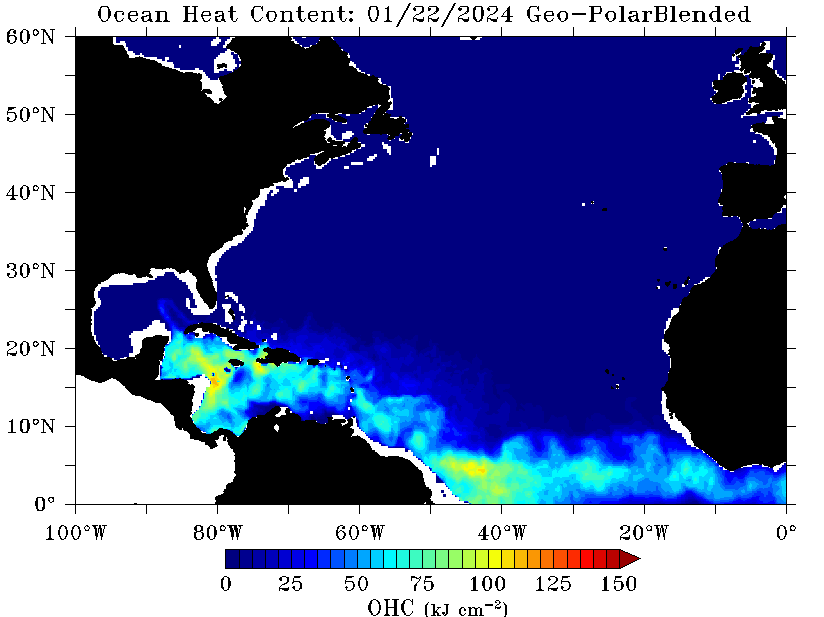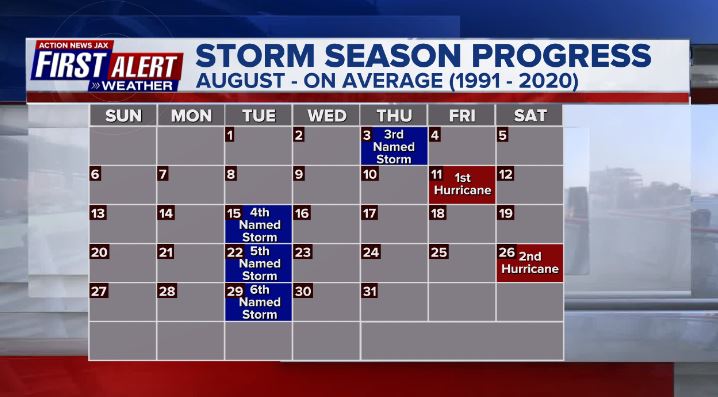Jacksonville, Fl. — The “Buresh Bottom Line”: Always be prepared!.....First Alert Hurricane Preparation Guide... City of Jacksonville Preparedness Guide... Georgia Hurricane Guide.
STAY INFORMED: Get the * FREE * First Alert Weather app
FREE NEWS UPDATES, ALERTS: Action News Jax app for Apple | For Android
WATCH “Preparing for the Storm”
WATCH “The Ins & Outs of Hurricane Season”
READ the First Alert Hurricane Center “Survival Guide”
LISTEN & WATCH “Surviving the Storm” - WOKV Radio & Action News Jax
***** ALWAYS CHECK & RE-CHECK THE LATEST FORECAST & UPDATES! *****
REMEMBER WHEN A TROPICAL STORM OR HURRICANE IS APPROACHING: Taping windows is *not* recommended & will not keep glass from breaking. Instead close curtains & blinds.
Realize the forecast cone (”cone of uncertainty”) is the average forecast error over a given time - out to 5 days - & *does not* indicate the width of the storm &/or where damage that might occur.
*** LOCAL (Jacksonville/NE Fl./SE Ga.) IMPACTS FROM THE TROPICS: Rip currents & an easterly swell (waves) at the beaches by late Sunday into early next week...
Heavy rain threat & - perhaps - gusty winds mid to late next week depending on strength & location of potential Gulf system...
The Atlantic Basin Overview:
Franklin hit Haiti & the especially the Dominican Republic with very heavy rain Wed. The storm will now stay over the Southwest Atlantic while turning rather sharply to the north with some distant impacts (waves & rip currents) on the U.S. east coast. There’s likely to be more significant impacts Bermuda by Tuesday & for parts of Nova Scotia & Newfoundland mid to late next week.
There continues to be signals - albeit inconsistent - of Gulf of Mexico development next week - which originate from a disturbance moving northward from over or near Central America. This potential development could have impacts on some part of the Gulf Coast &/or Florida next week. It does appear this disturbance will be moving away by late next week & before the Labor Day weekend.
(1) Once tropical wave ‘90-L’ is tropical storm “Franklin” (upgraded late Sunday) over the Northern Caribbean & is now east of the Bahamas over the SW Atlantic getting ready to make its sharp turn to the north/NW. Westerly wind shear is slowly diminishing but still having an impact on Franklin with the center almost entirely exposed early Fri. to the northwest of the strong convection. The combination of lessening shear plus upper level diffluence thanks to a trough of low pressure to the north should lead to an eventually strong hurricane over the Western Atlantic with some impacts for Bermuda by about late Mon. into Tuesday followed by at least some threat to Newfoundland & Nova Scotia by late Wed./Thu. And Franklin should be strong enough - while still well to the east of Florida - by Sunday/Monday/Tuesday to produce an easterly swell at area beaches resulting in a heightened rip current risk all up & down the U.S. eastern seaboard.
The forecast track is pretty straight forward with a well established alleyway across the Western Atlantic with Franklin accelerating over the weekend while maturing then bending rather gently to the northeast once at about the latitude of Bermuda & the Carolina’s. Franklin should be at about Jacksonville’s latitude but 1,000+ miles to the east Mon. morning.





(2) A very broad & weak area of low pressure has formed emanating from a disturbance over & near Central America. The long range forecast remains highly uncertain given a wide disparity in forecast model solutions not to mention less than ideal - especially early on - conditions for organization/intensification. It would be prudent to not “jump” on any single forecast model solution but rather look at the aggregate or ensemble of the models which do *relatively consistently* hint at least on some kind of system developing over the Gulf of Mexico next week. The European has been & continues to be the most emphatic model on eventual development... along with the Canadian forecast model (though I’m not particularly a fan typically of the CMC). The American GFS model has basically stuck with an elongated surface trough of low pressure with a surge of tropical moisture with a trend toward weak low pressure upon approach to Florida.
Timing: over the northwest Caribbean this weekend... far Southern Gulf late Sunday into Monday... starting to accelerate to the northeast over the Eastern Gulf Tue./Wed. Highest potential impacts on Florida from late Tue. through Wed. into early Thu. depending, of course, on the exact track & intensity of any system named (Idalia) or not.
Strength: while sea surface temps. & oceanic heat content are very warm (usually are this time of year), that alone will not result in a significant storm. Other factors have to be considered, especially wind shear & mid & upper level moisture. Neither - especially shear - are very favorable right now. There will be some decrease in the wind shear next week as the system approaches land while moisture (humidity) appears to be quite favorable.
Summary: While not a high confidence forecast at this point, it does look like a tropical system “of some sort” will eventually manifest itself over the Gulf with a movement some semblance of north (probably northeast)... & eventually a threat to some part of the U.S. Gulf coast &/or Florida. There will be lots of folks traveling late next week with Labor Day weekend just around the corner so stay up to date on the latest forecasts.
The 2nd image below is the European 500mb (~30-35,000 feet) model forecast for Monday, Aug. 28th. The alleyway for Franklin is clear over the W. Atlantic with the Bermuda high displaced far to the east while a trough of low pressure moves into the Eastern U.S. The disturbance “wanna-be” near the Gulf - if it develops - will have a tendency to get pulled northward given the strong continental high (”heat dome”) over the Central U.S. shifting more west while some semblance of troughing remains over/near the Eastern U.S.

Satellite sector below centered on the E. Pacific shows the disorganized & weak disturbance that could lead to Gulf development near the NW Caribbean & Yucatan Channel as well as an upper level low spinning over the W. Gulf helping to pull the disturbance north while also causing a good deal of wind shear.

(3) ‘98-L′ was upgraded to tropical storm “Emily” Sun. morning over the Eastern Atlantic after coming off the coast of Africa last Wed. & deemed dissipated Mon. morning. Conditions are becoming less favorable for regeneration as the remnants get pulled north & accelerate over the N. Atlantic through the weekend.


(4) another strong tropical wave - ‘92-L’ came off the coast of Africa last weekend. This wave may develop but appears destined to stay far out to the east over the Atlantic.



Check out the upper oceanic heat content (UOHC) [tropical cyclone heat potential/TCHP] across the SW Atlantic, Gulf & Caribbean. The warmth is very deep. But keep in mind warm ocean temps. alone doesn’t necessarily equate to a “big” hurricane season (need other ingredients & factors to be favorable too) but it’s obvious there is a lot of very warm water at great depths over the Caribbean & Gulf of Mexico:




Water vapor loop (dark blue/yellow is dry mid & upper level air):


July tropical cyclone origins:
Averages below based on climatology for the Atlantic Basin for August:

Wind shear:




Saharan dust spreads west each year from Africa by the prevailing winds (from east to west over the Atlantic). Dry air - yellow/orange/red/pink. Widespread dust is indicative of dry air that can impede the development of tropical cyclones. However, sometimes “wanna’ be” waves will just wait until they get to the other side of - or away from - the plume then try to develop if other conditions are favorable. In my personal opinion, way too much is made about the presence of Saharan dust & how it relates to tropical cyclones. In any case, the peak of Saharan dust typically is in June & July.

2023 names..... “Idalia” is the next name on the Atlantic list (names are picked at random by the World Meteorological Organization... repeat every 6 years). Historic storms are retired [Florence & Michael in ’18... Dorian in ’19 & Laura, Eta & Iota in ‘20, Ida in ‘21 & Fiona & Ian in ‘22]). In fact, this year’s list of names is rather infamous with “Katrina”, “Rita” & “Wilma” retired from the ‘05 list & “Harvey”, “Irma”,“Maria” & “Nate” from the ‘17 list. The WMO decided - beginning in 2021 - that the Greek alphabet will be no longer used & instead there will be a supplemental list of names if the first list is exhausted (has only happened three times - 2005, 2020 & 2021). The naming of tropical cyclones began on a consistent basis in 1953. More on the history of naming tropical cyclones * here *.





East Atlantic:





Mid & upper level wind shear (enemy of tropical cyclones) analysis (CIMMS). The red lines indicate strong shear:
Water vapor imagery (dark blue indicates dry air):

Deep oceanic heat content over the Gulf, Caribbean & deep tropical Atlantic. The brighter colors are expanding dramatically as we near the peak of the hurricane season.:

Sea surface temp. anomalies:


SE U.S. surface map:

Surface analysis centered on the tropical Atlantic:

Surface analysis of the Gulf:

Caribbean:

GFS wave forecast at 48 & 72 hours (2 & 3 days):


Atlantic Basin wave period forecast for 24, 48 & 72 hours respectively:



East/Central Pacific:
I wrote about “Hilary” near the top after the Atlantic waves. Elsewhere.....





West Pacific:

Global tropical activity:

“Damrey” forecast to stay east of Japan:

“Saola” is forecast to strengthen into a formidable typhoon not far from the Philippines while making a loop & moving very slowly:



Cox Media Group











